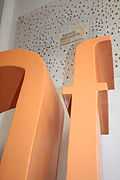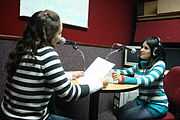Universidad de Monterrey
| University of Monterrey | |
|---|---|
| Universidad de Monterrey | |
 University of Monterrey seal | |
| Motto | Homo Hominis In Servitio Perficitur |
| Motto in English | The man is only realized at the service of the man |
| Established | July 08, 1969 |
| Type | Private university |
| President | Dionisio Garza Medina |
| Rector | Dr. Antonio J. Dieck Assad (Since 2009) |
| Students | 12,463 (2009) [1] |
| Undergraduates | 7,917[1] |
| Postgraduates | 501[1] |
| Other students |
220 (Bachelor of Nursing)[1] 729 (Medical Specialties)[1] 3,096 (High School Students)[1] |
| Location |
Monterrey, Nuevo León, 25°39′38″N 100°25′12″W / 25.660594°N 100.420117°WCoordinates: 25°39′38″N 100°25′12″W / 25.660594°N 100.420117°W |
| Campus | Urban, 350,000 m² [2] |
| Athletics | Troyanos (Trojans) |
| Colors | yellow and black |
| Affiliations |
ANUIES ISQOLS ASQ NAFSA IIE |
| Website | www.udem.edu.mx |
The University of Monterrey (in Spanish: Universidad de Monterrey, acronym "UDEM") is a Roman Catholic institution of higher learning located in Monterrey, Mexico.
UDEM was founded by the Daughters of the Immaculate Mary of Guadalupe, the nuns of the Sacred Heart, the Marist Brothers and the La Salle members, supported by an association of Catholic citizens. The idea originated from a recommendation given by the Second Vatican Council to use educational activities in favor of teaching the principles of the catholic doctrine.
The founding religious groups already had a deep history in Monterrey. The Society of the Sacred Heart of Jesus had been working in Monterrey since 1908, and the Sisters of Immaculate Mary of Guadalupe founded Labastida University in 1951, and had been running Labastida College since 1919, an institution devoted to the education of girls and young ladies. On the other hand, the Marist Brothers had been working in Monterrey since 1905, and La Salle Brothers, who had left Mexico during the Revolution war, returned in 1942 to Monterrey to found the Instituto Regiomontano.
On July 8, 1969, the university was recognized as such by the state of Nuevo Leon and on September 8 of the same year it began operating as an educational institution housed in 5 different facilities owned by the very same groups and associations that funded it, such as Labastida school.
Currently, UDEM educates over 12 thousand students, including high school students, undergraduates and postgraduates. The school offers 4 high school modes, 35 majors, 15 baccalaureate degrees and 29 medical specialties and doctorates. UDEM offers a number of choices to study abroad; UDEM has established bilateral, reciprocal and unilateral agreements, as well as arrangements through academic exchange agencies. In 2002, UDEM signed 26 new bilateral agreements with universities in the United States – such as the University of California – Berkeley and other universities in Spain, Italy, Belgium, England (such as University College, London), Germany and France (such as the Lycée Bossuet-Notre Dame, in Paris).[citation needed]
History
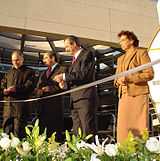
By 1972, UDEM had 22 majors and 3 baccalaureate degree programs. That same year, 7 more academic divisions were created, amongst which were the Arts and Media Sciences, Education, Economics, Law, Mathematics, Health Studies and Social Studies.[3] In 1979, a Mexican philanthropist named Roberto Garza Sada formed the Association for Educational Development, which sole purpose was to buy 35 acres of land in which they would build the actual campus for UDEM.

Seal

Originally created by Ignacio Villareal Junco, UDEM's seal consists of three books meant to symbolize the letters "U" and "M" in Universidad de Monterrey. The university colors are yellow and black and are usually added to the seal image. According to its creator, the color yellow signifies the light of knowledge, sensibility and intuition.
In 2002, two circles which contain the Latin phrase that currently serves as the University's motto were added. This phrase Homo Hominis In Servitio Perficitur when translated means "Man is perfected in the service of man". Finally, laurels were added to the image which symbolize triumph and success.
Campus
UDEM has only one university campus located in San Pedro Garza Garcia, Nuevo Leon, Mexico. But also has three high school locations (translated as units from the Spanish word for Unidades). Said locations are Unit San Pedro (USP) located in the boundaries of the university campus, Unity Valle Alto (UV) located in the Estanzuela, Monterrey, Nuevo Leon, Mexico[5] and Unit Fundadores (UFU) located in Escobedo, Nuevo Leon, Mexico.[6] In addition classes of the Technical Baccalaureate are offer in the CUFM facilities[7] and the Nursing Degrees on Campus CHRISTUS Health Muguerza Conchita Hospital.[8]
Some of the businesses that have a presence on the main UDEM campus are:
- Bachiller, Bookstore and stationery[9]
- Copimex of Monterrey, Copy and Print Center
- Exa Campus Store (Apple Inc. Authorized Campus Store) [10]
- Starbucks Coffee
- Subway (restaurant)
- Banorte
- Santander Serfin
- 7-eleven
Rector's Building and CIAA

On September 2001, after 10 years of planning, construction began on the Rector's building which is over 27 thousand ft². The building also houses the CIAA or Center for Information and Student Attention as translated to English. On 2003 it was inaugurated. Local Architect Bernardo Hinojosa[11] oversaw the project.
The building also houses the vice-rectory for high school education, college education, development and administrative departments. A red and black sculpture called La Serpentina adorns the main plaza of the building, it was created by Fernando González Gortázar, an artist from Guadalajara. The red color symbolizes the warmth of human beings and as the flame within all of us to succeed.
CCU

Inaugurated in 1999 by former Mexican President Ernesto Zedillo, CCU stands for Centro de la Comunidad Universitaria and translates to Community College Center. The CCU is a recreational area for students which also houses the Culture department (in charge of all artistic events within the University or by the University's alumni), Pastoral Care department, the student council headquarters, a small chapel, the cafeteria, the music rooms, an auditorium, a common room and the film club.
A yellow statue entitled "The Man" adorns the main lobby. It was made by Oaxaca-born artist Rufino Arellanes Tamayo, who has also contributed to UDEM with countless other works and serves as a symbol for the institution. In his words, The Man represents the origin, middle and end of culture.
There is also a half-moon sculpture, adorned with closed fists, called The Tree of The Community created by Jorge Elizondo. It's also found on the CCU's main lobby and serves as a reminder of all the people and groups that believed in the concept of a school such as UDEM. Each hand has a name plate at its base.
The Bell

When a student graduates, one of the most symbolic processes before fully graduating is to sound the bell. Its name is Vox Veritas which means "The Voice of Truth" and must be tolled three times total when a student has finished the requirements for his/her degree.
Each toll means a commitment the student makes to always uphold the truth, fight for justice and remain honest throughout his or her life. If a student graduates Magna cum laude or Summa cum laude, the amount of tolls raises to four or five. It is one of the school's oldest traditions.
Library
In 1987 the library system of UDEM was consolidated and still operates today from the main/central library located at UDEM's campus and three other department libraries found in UDEM's high schools. UDEM's library counts with up to 44 direct collective bargaining with local and national institutions, a total of 222,524 volumes of books, videos and E-book, a collection of 408,589 well known and globally recognized academic journals (in both press and on-line), a data base of 23,234 archived documents from institutions such as EBSCO, ProQuest, Wilson, Infolatina, Britannica, Ocenet, Gale and Routledge.
Among the library's most important collections, you can find:
- Colección Xavier Moyssén about which deals with Mexican Art History and is restricted to unauthorized personnel.
- INEGI's Library
Student Dorms

In Mexico, it is uncommon for college students to leave their homes and start living by themselves. Fraternities and sororities are rarely heard of. However, schools like UDEM receive a vast amount of foreign exchange students and, even when it's uncommon, people will eventually leave their homes and begin living independently.
For these reasons, UDEM started a student housing project called Residencias UDEM meaning UDEM residences. They were inaugurated in 2006 after 13 months of being planned and occupied over 14 acres within the grounds of the UDEM's campus. The project was overseen by authorities from Harvard university, Yale, Loyola and the University of the Americas (UDLA), as well as benefactors like Jane Wright from the Hanbury Evans Wright Vlattas firm. The dorms house up to 450 students.
Educational Offering
UDEM offers to date:[12]
4 High Schools Programs
- Bilingual Program
This program is given in Spanish and focuses on the knowledge and self-identity of the Mexican people. Students will learn to properly speak English as a second language and choose whether or not to study abroad in countries such as the USA, Canada or Europe. The program also features student trips to several Spanish speaking countries such as Argentina, Chile, Cuba, Spain, Panama and Peru.[13]
- Bicultural Program
Designed for students who already are fluent in English, this program is given mostly in English and gives the option to choose between its modalities in English, German or French. Students also will learn about other cultures in favor of mutual respect and understanding. The featured exchange options are studying in Germany, Canada, USA, France, England and Switzerland.[14]
- International Program
The international program, also known as the International Baccalaureate (IB), is perhaps the most recognized of all the others simply because it's actually an evaluated course by the International Baccalaureate Organization (IBO) which is headquartered in Geneva. The program features a multicultural edge and a highly demanding academic experience. Mixing science with human and social studies, IB works on developing intellectual skills on students, as well as communication skills, investigation methods, critical analysis and argumentative abilities that are reinforced with international experiences.[15]
- Technical Program
This program is specifically targeted to obtain a certificate so students can continue their professional studies in one of 4 branches, at the same time their introduction into the business world is expedited. The 4 course branches are System Analysis, Accounting, Strategic Sales and Publicity Image.[16]
35 Undergraduate Programs
Arts, Design and Architecture Division
- Architecture (ARQ)
Focusing on construction and design, this major pushes students to create buildings and structures stemming from ideas that are both socially responsible and artistic. Students majoring in architecture will have a deep understanding of a creative process that undergoes the design, project planning, construction and supervision of a building.[17]
- Arts (LA)
With classes that are taught by some of the most influential artists in the region, the arts major focuses on the visual production, on culture and on developing fresh ideas in an already highly cultural market. The university counts with the Xavier Moyssén collection, which is a bibliographical recount of Mexican modern art.[18]
- Interior Design (LINT)
Students are taught a mix between design and architecture, focusing on creating functional spaces taking in consideration the construction and furnishing of a place while maintaining certain harmonious quality to it.
- Graphic Design (LDG)
The course plan include classes that maintaining the Mexican identity in graphic design, as well as a global take on the graphic design everywhere. Students are taught how to use the basic tools for any graphic artist, both old and new, as well as how to compose a piece, be it a minimalist design for a movie poster to a whole publicity campaign .
- Fashion Design (LDTM)
Students will be given the tools and lessons on how to use them, but ultimately, it will be up to them to fully design fashion pieces. Fashion Design students participate an international runway show.
Health Sciences Division
- Biomedical Engineering (IBI)
Covering the fields of clinical engineering, biomechanics, biomaterials and medial supplies, students are led to improve their creative prowess and imagination, all the while breeding a taste for technology into them. This major features a work field in operational, commercial or administrative functions of production and innovation.
- Nursing (LEN)
Aimed towards people interested in developing nursing skills and taking care of people.
- Nutrition (LNU)
Students will be capable of preventing and treating some of the main health issues dealing with weight and dieting. This major balances it's lessons between health, sports, biotechnology, psychology, marketing and gastronomy.
- Psychology (LPS)
This major is focuses on the field of clinical psychology and extends to organizational, educational, social and child psychology. The courses are a blend of theoretic classes and work practice were the student can develop in the public sector, be it at hospitals, day-care centers, governmental health institutions, psychology aid centers and educational facilities, or work for the private sector.
- Dentistry (MCD)
Students will develop their skills with such versatility due to the option of working with state of the art equipment and the ability to work at health centers such as the Metropolitan Hospital or the Public Health Center (Secretaría de Salud).
- Medicine (MCP)
Perhaps the most sought after field of study in the Health Sciences Division, students engage in a rigorous curriculum consisting of basic and clinical sciences. Clinical rotations are performed in the most important hospitals in Monterrey, with world class attending physicians serving as professors and mentors. At the culmination of the degree, students are eligible to take the national medical residency exam in Mexico and/or sit for the United States Medical Licensing Exam (USMLE).
Law and Political Science Division
- Political Science and Public Administration (LPA)
Students will become connoisseurs of the national and international historical context, the processes of political participation and political theory, as well as the methods to analyze and comprehend a political system.
- International Studies (LEI)
This major forms people capable of analyzing, designing, producing and running diagnostics on problem solving strategies worldwide as a response to the social needs, in the context of a political, economic and cultural background.
- Law (LDE)
One of the eldest majors cursed in the university, specializes in forming professionals capable of solving complex juridical problems. The students will have the opportunity to study through professional practices and the Catedra Laboris, a special practice course imparted by lawyers and professionals known internationally.
Humanities and Education Division
- Educational Sciences (LED)
It's the first major in Mexico which focuses on the theoretical-practical curriculum oriented to develop teaching skills that can be used in the handling of groups, coordination of projects, administration and evaluation of educational processes.
- Information and Communication Sciences (LCIC)

Students can work and perfect his/her abilities in the following laboratories:
- Agencia Informativa UDEM
- Transaled, UDEM's Information Agency is where all journalism classes are taught. The main classes are World Journalism (Periodismo Mundial), Informative Journalism (Periodismo Informativo), Editorial Journalim (Periodismo de Opinión) and Online Journalism (Periodismo Multimedia). Over 100 students begin to develop redacting, editing, monitoring and photographic abilities in this classes, as well as the design of both a news paper and a web page, a radio news broadcast and a news data base.[19]
- Inaugurated in 1996, the agency has had over 8 thousand news and reports published in different media outlets. El Nuevo Foro is the college newspaper and has been for over 26 years. Since 2009, the agency also distributes news about student life through a Twitter feed. @AgenciaUDEM
|
- Radio station UDEM
- On September 8, 1994 was conducted the first transmission of Radio UDEM the 90.5 FM station with only 1000 watts of power, however in 2005 they increased capacity to 3,000 watts of power with which its usual programming stretched to year round transmissions.
- All programming is designed and made by students of the second course of radio, who also participate in the entire process of issuance (planning, pre-production, operation, conduction and execution of programs).
- From 2006 they began transmitting over the Internet. mms://radioudem.udem.edu.mx/radio[20]
- Centro de Medios (CEDEM)
- The Center for Mass Media doubles as the classroom and practice center where students learn how to operate a radio broadcast, a live television broadcast and cinematography. Inaugurated in 1990, in counts with 5 video editing modules, personal HD cameras, wireless microphones, professional lighting, television format cameras with a prompter and a Television studio.
|
- Psychopedagogy (LPP)
Inaugurated in 2004, it's the only major in the northeast of Mexico of its kind. Students will be able to design solutions for school advancements of other students at any educational level.
- Sociology (LS)
Students will analyze and interpret several distinct social phenomenons, create programs and development plans for problem solving and improve institutions, organizations and communities.
- Literature (LL)
Graduate students will acquire the necessary knowledge and practice to create a literary work. With this new-found abilities, they will be able to participate in the fields of journalism, editing, translating, Library science and teaching.
- Philosophy (LF)
Students develop project generating and directing abilities with social responsibility in mind, either working for the general public in governmental institutions or for the private sector.
- Human and Social Studies (LEHS)
This particular program reunites all the classical humanitarian sciences and social sciences, with an edge literature, philosophy, art, sociology and history.
Technology and Engineering Division
- Industrial Engineering (IIS)
Inaugurated in 1977, its main objective is to give students the capacity to design, administer and implement process systems, both productive and administrative. The program specializes in industry, quality, manufacture and logistics.
- Administrative Engineering
Focusing on the innovative aspects of technological development and business yield, this program promotes the design, implementation and evaluation of products and transformation processes.
- Mechatronics Engineering (IMT)
The concept for this major started as the answer to the specific heavy demand of corporations and industries to form innovative professionals, with entrepreneur driven qualities and the capacity to integrate knowledge about mechanical engineering, electronics and computer systems to their work.
- Information Technology Engineering (ITC)
Trainees in this major will know and apply the distinct computer technologies such as software, interweb, computer programming, computer hardware, user interface, among others.
- Animation and Special Effects (LAED)
Students majoring in this will specialize in designing and using basic concepts and practices to develop computer animation and digital effects, as well as learning how to produce interactive software.
Business Division
- Business Administration (LAE)
Students will be able to develop innovative and effective solutions with a global edge in the business world, this in return will push forward companies to fulfill their objectives. Students will have full usage of the business simulation laboratories and UDEM's business incubator to develop a well defined business project.
- UDEM's Business Incubator
- The Center for Incubation and Business Development (CIDEM) AKA the business incubator specializes in providing assessment, preparation and net access to all actual and potential entrepreneurs. CIDEM is created in 2005 and it's the first certified business center in Latin America with the model SBCD Mx, transferred from the Mexican Association for Small Business Development Centers and the Small Business Association (SBA).
- International Commerce (LIlN)
The objective is to form a global vision to participate in international business, identifying commercial opportunities, applying economic, legal and financial analysis, intercultural negotiations tactics and international logistics that permit the student design competition strategies in the private or governmental sector.
- Accounting and Finances (LCF)
Its goal being forming leaders with decision making capacities that drive companies and people to have a better positioning with strategic sales. Students of this major are analyzing and finance experts, with integrity.
- International Tourism (LTU)
To achieve a strategic edge in business, students are given theoretical and practical courses that help develop the skills they're going to need in managing and operating companies and organizations dedicated to several branches of tourism.
- International Finances (LFI)
This majors main goal is to make ethical professionals, committed with the values of business and administration experts of the economical resources, risks and financial models that permit a complete dominance of the international financial system out of the students.
- International Marketing (LMI)
Students participate in real business projects which will shape them into competitive professionals capable of developing innovative strategies and creative marketing that can be self-sustainable. They will also have the capacity to analyze market information, handle and apply technological tools, and have a strong sense of service and commitment to the wealth of any given corporation.
- Human Resources (LRH)
This major aims to make students become competitive entrepreneurs with leadership skills, focused in the development of work options within organizations, following a scheme of personal success and commitment to the achievement of the company's goals in which they grow in an ever changing and highly demanding environment
- Economics (LEC)
This program offers three specialties: Business Economy, Financial Economy and International Economy. The program features mandatory professional practices in global industries, financial markets and the public sector.
17 Postgraduate Programs
- Architecture, Design and Engineering
- Industrial Engineering
- Product Engineering
- Graphic Design
- Publishing and Editorial Design
- E-Marketing
- Health Sciences
- Obesity and Clinic Nutrition
- Gerontology
- Law and Social Sciences
- Business Law
- Merchant Law
- Education and Human Studies
- Educational Sciences
- Human Studies
- Early and Preschool Education
- Business
- Business Administration
- Hospital Administration
- Organizational Development
- Family Company Direction
- Quality and Service innovation
29 Medical Specialties
| Specialties | Sub specialties |
|---|---|
| Anatomical pathology | Gastroenterology |
| General Surgery | Angiology and Vascular Surgery |
| Internal Medicine | Maternal-fetal medicine |
| Radiology | Cardiothoracic surgery |
| Clinical Pathology | Geriatrics |
| Gynecology and Obstetrics | Urology |
| Pediatrics | Neonatology |
| Anesthesiology | Cardiology |
| Orthotics | Pulmonology |
| Medical Emergency | Neurosurgery |
| Ophthalmology | Plastic Surgery |
| Psychiatry | |
| General practitioner | |
| Otolaryngology | |
| Integrative medicine | |
| Nuclear medicine | |
| Obesity and Clinical Nutriology | |
| Gerontology |
In addition, students have 671 options of exchange in 56 countries, of which 24% are with universities included among the top 500 in the world.
Trojans
The Trojan is the school mascot and representative sports teams of UDEM. The name was chosen in 1981 and was, originally, just an American football team, which would win the championship in 1984 - 1985 from the National Educational Football Organization.
Today, the university counts with representative teams in soccer, futsal, basketball, volleyball, track and field, swimming, Taekwondo, archery and tennis.
|
Liderazgo
CELES UDEM
The Center for Student Leadership (CELES) has the mision to generate competence and leadership, rising the student's potential so they can transform society and transcend in it. CELES is dedicated to contribute to the formation of its students.[21]
Student Groups
Fomenting student participation through student groups is one of CELES strategies to create high performance leaders in a civic-political environment. This groups live out a formative process that includes: a preparation course, political campaign, election making process, an oath and a year to perform their duties.[22]
FEUDEM
The biggest representative organism in the student body. Its main goal is to serve and work as a bond with the university authorities, fomenting the sense of belonging and support the realization of diverse student projects.
Leadership Center and ¡Lánzate!
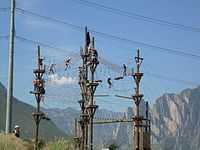
¡Lanzate! (Spanish for jump to or throw yourself at) is an enormous outdoor vivid team building exercise which allows you to develop competition skills, when you face situations that require a physical and emotional challenge, demanding new behaviors, right decisions and the abilities to work in teams (communication, planning and execution). Its main purpose was to promote experience education and an eco-friendly culture. The course is made up of rope lanes, rappel and hiking, besides offering national and international camping trips.[23]
The center was built according to the standards of ACCT (Association for Challenge Course Technology), which regulates the quality in this type of structures and counts with qualified instructors. The design of the programs was made following the guidelines of the Association for Experiential Education (AEE).[23]
Finally, the architectural design of the piece was in charge of Enrique Abaroa, as well as Challenge Towers, globally recognized for creating the "Discovery Course" which offers over 24 different challenges. Only four like this exist in the world, and this is the only in Mexico.[24]
UDEM OpenCourseWare
In 2007 through the OpenCourseWare Consortium project, the University of Monterrey offers teachers and students anywhere around the world a collection of free access online courses with content of the graduate programs offered in the university. This way, UDEM hopes to contribute to the overall responsibility of educating and serving the community.[25]
Community Service

Altruistic Youths Thinking of Mexico
JALPEM as it is commonly known is a student association whose mission is to unite the work of different majors in the university and route their capabilities with the purpose to offer them as service in the less favored sectors in the country. Inspired by the wish to help, health students and volunteers organize support brigades in this areas and work to achieve the four pillars of physical and mental well being: Health, Education, Living Accommodations and the absence of Hunger.
Through more than 5 years, UDEM has accomplished an impact in several regions and in different aspects, such as getting medical, psychological and dental care to more than 3,200 people since its inauguration.
Medical Brigades
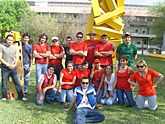
UDEM's Medical Brigades is a high performance group dedicated to the prevention of accidents and support to the community during events, such as practices and civil protection support, as well as helping the Red Cross
Phi Delta Epsilon: International Fraternity
Phi Delta Epsilon is a fraternity that has as a main goal, create medics with integrity and a life-time commitment to their principles of philanthropy, deity, and education through companionship, service, assessment and ethical upbringing
UDEM is the only university in all of Mexico to count with a chapter of this fraternity
Health and Development Center (Cesade)
For more than 20 years now, CESADE has offered programs that met the needs in the health, psychology and education areas to the communities with little resources in the municipalities of San Pedro and Santa Catarina. CESADE is made up of a team of multidisciplinary students borrowed from the Social Service fields, coordinated by professionals from distinct areas and UDEM's academics, which work together looking to establish and integral development in each and every single individual.[26]
Early Education Self-Managed Centers (CAEI)
Through this centers, UDEM has been able to provide an educational alternative to infants 3 to 4 years of age from impoverished zones for more than 15 years.[26]
Summer Camps
For more than 20 years, UDEM has offered recreational and formative alternatives to more than 2 thousand children and mothers from impoverished zones.[26] Estos cursos principalmente ofrecidos en Julio son organizados e impartidos en cinco sedes por alumnos de Servicio Social.[26]
Accreditation
The University of Monterrey has the following accreditations:[27]
- SACS (Southern Association of Colleges and Schools)
- AMIESIC - Asociación Mexicana de Instituciones de Educación Superior de Inspiración Católica (Mexican Association of Higher Education Institutions with Catholic Inspiration)
- ASINEA - Asociación de Instituciones de Enseñanza de Arquitectura de la República Mexicana (Mexican Association of Architecture Teaching Institutions)
- AMFEM - Asociación Mexicana de Facultades y Escuelas de Medicina (Mexican Association of Medicine Schools)
- CACEI - Consejo de Acreditación de la Enseñanza de la Ingeniería (Engineering Teaching Accreditation Council)
- CONAC - Consejo de Acreditación de la Comunicación (Communication Accreditation Council)
- CNEIP - Consejo Nacional para la Enseñanza e Investigación en Psicología (National Council for Teaching and Research in Psychology)
- College Board
- FIMPES - Federación de Instituciones Mexicanas Particulares de Educación Superior (Federation of Mexican Private Higher Education Institutions)
- IBO - International High School Organization
- ISA - International Schools Association
- Puerto Rico Physician's Court
- ACCECISO - Asociación para la Acreditación y Certificación de Ciencias Sociales (Association for the Certification and Accreditation of Social Sciences)
- CACECA - Consejo de Acreditación en la Enseñanza de la Contaduría y Administración, A.C. (Accounting and Administration Teaching Accreditation Council)
- COMAEM - Consejo Mexicano para la Acreditación de la Educación Médica (Mexican Health Education Accreditation Council)
- CONAC - Consejo de Acreditación de la Comunicación (Communication Accreditation Council)
- CONACE - Consejo Nacional para la Acreditación de la Ciencia Económica (National Council for Accreditation of Economic Science)
Affiliations
- AACBS (Association to Advance Collegiate Schools of Business)
- Academia Nacional de Arquitectura de la Sociedad de Arquitectos Mexicanos, Capítulo Monterrey
- American Institute of Graphic Artists (AIGA)
- American Library Association (ALA)
- American Society of Quality Control (ASQ)
- Asociación de Empresas en Tecnologías de Información (AETI)
- Asociación de Facultades, Escuelas e Institutos de Economía de América Latina (AFEIEAL)
- Asociación de Instituciones de Educación en Tecnologías de Información (ANIEI)
- Asociación de Instituciones de Enseñanza de la Arquitectura de la República Mexicana (ASINEA)
- Asociación Latinoamericana de Desarrollo Organizacional
- Asociación Mexicana de Bibliotecarios (AMBAC)
- Asociación Mexicana de Escuelas Acreditadas por la Organización del Bachillerato Internacional (AMEXCAOBI)
- Asociación Mexicana de Escuelas de Graduados en Administración (AMEGA)
- Asociación Mexicana de Facultades y Escuelas de Medicina (AMFEM)
- Asociación Mexicana de Profesionales en Informática (AMPI)
- Asociación Mexicana de Universidades Privadas (AMUP)
- Asociación Mexicana para la Educación Internacional (AMPEI)
- Asociación Nacional de Escuelas de Diseño Gráfico, A.C. (ENCUADRE)
- Asociación Nacional de Facultades y Escuelas de Contaduría y Administración (ANFECA)
- Asociación Nacional de Facultades y Escuelas de Derecho (ANFADE)
- Asociación Nacional de Instituciones de Docencia e Investigación Económica (ANIDIE)
- Asociación Nacional de Universidades e Instituciones de Educación Superior (ANUIES)
- Association for Computing Machinery (ACM)
- Association of American Law School (AALS)
- Association of College and Research Libraries (ACRL)
- Association of International Education Administrators (AIEA)
- Association of International Educators (NAFSA)
- Australian Center on Quality of Life, Section: International Well being Group (ACQOL)
- British Design and Art Direction (D&DA)
- Cámara Nacional de la Industria Electrónica, de Telecomunicaciones y de Tecnologías de Información (CANIETI)
- Center for Academic Integrity (CAI)
- Centro Nacional de Evaluación (CENEVAL)
- Consejo Nacional para la Enseñanza y la Investigación de la Ciencia de la Comunicación (CONEICC)
- Cluster Aeroespacial
- Cluster Automotriz
- Cluster de Medios Interactivos de Nuevo León
- Colegio de Arquitectos de Nuevo León, A.C. (CANL)
- Colegio de Economistas de Nuevo León
- Color Marketing Group (CMG)
- Comisión Estatal Interinstitucional de Enfermería (COEIE)
- Comité Interinstitucional para la Formación y Capacitación en Recursos Humanos e Investigación en Salud (CIFRHS)
- Community Indicators Consortium (CIC)
- Consejo de Software de Nuevo León (CSoftMty)
- Consejo Nacional para Asuntos Bibliotecarios de Instituciones de Educación Superior (CONPAB)
- Consortium for North American Higher Education Cooperation (CONAHEC)
- Council of Logistics Management (CLM)
- Council for the Advancement and Support of Education (CASE)
- Design Management Institute (DMI)
- Family Business Institute
- Federación Mexicana de Asociaciones de Facultades y Escuelas de Enfermería (FEMAFEE)
- Federación Mexicana de Facultades y Escuelas de Odontología (FMFEO)
- Institute of Industrial Engineers (IEE)
- Institute of International Education (IIE)
- Institute of Management Accountants (IMA)
- Instituto de Contadores de Nuevo León (IMCP)
- Instituto Mexicano de Ejecutivos de Finanzas (IMEF)
- Instituto para el Desarrollo del Talento en Tecnologías de Información (IDETTI)
- International Federation of Library Associations (ILFA)
- International Game Developers Association (IGDA)
- International Organizational Development Association (IODA)
- International Society of Quality of Life Studies (ISQOLS)
- ERIAC, Capital Humano
- Online Computer Library Center (OCLC)
- Organization Development Network (ODNETWORK)
- Organization for Economic Co-operation and Development (OECD)
- Phi Delta Epsilon International Medical Fraternity (ΦΔΕ)
- Red de Bibliotecas de Instituciones de Educación Superior del Noreste (REBIESNE)
- Sociedad de Arquitectos de Nuevo León, A.C. (SANL)
- Society for News Design (SND)
External links
References
- ↑ 1.0 1.1 1.2 1.3 1.4 1.5 "La UDEM en Numeros" (in Spanish).
- ↑ http://www.udem.edu.mx/acerca/masacerca/historia/8476
- ↑ http://www.udem.edu.mx/acerca-masacerca-historia-8476.html
- ↑ http://www.udem.edu.mx/micrositio/nota/centrorobertogarzasada/8251
- ↑ http://www.udem.edu.mx/XStatic/udem/template/detallesubtema.aspx?st=170&se=Prepa
- ↑ "Unidad Fundadores" (in Spanish).
- ↑ http://www.udem.edu.mx/XStatic/udem/template/msdetallenota.aspx?ms=bet&st=970&sTema=Ubicaci%C3%B3n&ssTema=Bachillerato%20T%C3%A9cnico
- ↑ http://www.christusmuguerza.com.mx/escuela-de-enfermeria/
- ↑ http://papeleriabachiller.com/tienda/pages.php?page=ubicacion
- ↑ http://www.milenio.com/node/618256
- ↑ http://www.bernardohinojosa.com.mx/contenido.asp?seccion=5 (In Spanish)
- ↑ http://www.udem.edu.mx/acerca/masacerca/la_udem_en_numeros/327
- ↑ http://www.udem.edu.mx/prepa-masacerca-caracteristicas-450.html (In Spanish)
- ↑ http://www.udem.edu.mx/prepa-masacerca-caracteristicas-466.html (In Spanish)
- ↑ http://www.udem.edu.mx/prepa-masacerca-caracteristicas-469.html (In Spanish)
- ↑ http://www.udem.edu.mx/bet (In Spanish)
- ↑ http://www.udem.edu.mx/carreras-arquitecto-73.html (es)
- ↑ http://www.udem.edu.mx/carreras-licenciadoenartes-85.html
- ↑ Universidad de Monterrey (2011). "Agencia Informativa UDEM" (in Español). Unknown parameter
|añoacceso=ignored (help) - ↑ Universidad de Monterrey (2011). "Radio UDEM" (in Español). Unknown parameter
|añoacceso=ignored (help) - ↑ Universidad de Monterrey (2011). "CELES" (in Español). Unknown parameter
|añoacceso=ignored (help) - ↑ Universidad de Monterrey (2011). "Grupos Estudiantiles" (in Español). Unknown parameter
|añoacceso=ignored (help) - ↑ 23.0 23.1 http://www.udem.edu.mx/Xstatic/udem/template/micrositios.aspx?ms=lanzate
- ↑ http://www.elporvenir.com.mx/notas.asp?nota_id=130307
- ↑ udem.edu.mx - Acerca de OCW — UDEM OpenCourseWare, 2007-02-20
- ↑ 26.0 26.1 26.2 26.3 Universidad de Monterrey (2011). Centro de Salud y Desarrollo "Comunidad" (in Español). Unknown parameter
|añoacceso=ignored (help) - ↑ http://www.udem.edu.mx/XStatic/udem/template/msdetallenota.aspx?ms=english&st=2058&sTema=Accreditations&ssTema=Memberships
| ||||||||

